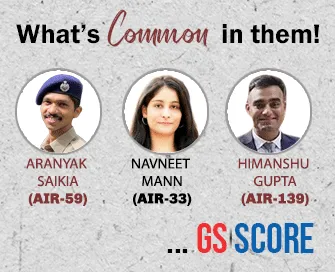

13th June 2025 (9 Topics)
Mains Issues
Context
India has ranked 131 out of 148 countries in the World Economic Forum's Global Gender Gap Report 2025, slipping two places from its position last year. With a parity score of just 64.1%, India is among the lowest-ranked countries in South Asia,
Global Gender Gap Index (GGGI)
- Published by: World Economic Forum (WEF) annually.
- Purpose: Measures gender-based disparities across countries and tracks their progress.
- Four Core Dimensions:
- Economic Participation and Opportunity
- Educational Attainment
- Health and Survival
- Political Empowerment
- Scoring Range: 0 (complete inequality) to 1 (complete equality).
India’s Overall Ranking and Score (2025)
- Global Rank: 131 out of 148 countries (? 2 ranks from 129 in 2024).
- Overall Score: 1% parity.
- Regional Context:
- India is one of the lowest ranked in South Asia.
- Ranked below: Bhutan (119), Nepal (125), Sri Lanka (130).
- Ranked above: Maldives (138), Pakistan (148).
India’s Performance by Dimension
- Economic Participation and Opportunity
- Score: 7% (? 0.9 percentage points from 2024).
- Labour Force Participation: Static at 9%.
- Estimated Earned Income Parity: 9% (? from 28.6%).
- Observation: Improvement noted, but income gaps remain significant.
- Educational Attainment
- Score: 1% – near parity.
- Reasons: Higher literacy and tertiary enrolment among females.
- Concern: Education gains not translating into economic/leadership roles.
- Health and Survival
- Improvement: Parity in sex ratio at birth and healthy life expectancy.
- Caveat: Overall life expectancy declined ? parity is relative, not absolute.
- Political Empowerment
- Parliamentary Representation: ? to 13.8% (from 14.7% in 2024).
- Ministerial Roles: ? to 5.6% (from 6.5%).
- Trend: Second year of decline, far from 30% peak in 2019.
Global Trends and Key Observations
- Top 5 Countries:
-
- Iceland (1st for 16th consecutive year)
- Finland
- Norway
- United Kingdom
- New Zealand
- Global Gender Parity Score (2025):8% – Best post-pandemic improvement.
- Estimation: At the current pace, full global parity is 123 years away.
- Leadership Disparity: Women = 41.2% of workforce, but only 28.8% of leadership roles.
Implications for India
- Economic Impact:
- Gender parity contributes to inclusive and resilient economic growth.
- WEF reiterates that closing gender gaps boosts GDP, innovation, and governance.
- Policy Challenges:
- Stagnation in economic participation despite education parity.
- Decline in political representation indicates institutional and cultural barriers.
- Need for stronger gender-responsive policymaking, especially in labour, leadership, and political domains.
India: Way Forward
- Implement Gender Budgeting across ministries and states.
- Promote women’s leadership in politics (e.g., reservation in legislatures).
- Strengthen support systems for working women (childcare, maternity benefits).
- Address informal sector vulnerabilities where majority of female labour resides.
- Bridge the gap between educational attainment and workforce participation.


Mains Issues
Context
The Union Ministry of Finance mandated that all Central and Centrally Sponsored Schemes (CSSs) be subjected to third-party evaluation before seeking extension beyond March 31, 2026. This marks a significant shift towards performance-based governance, fiscal discipline, and evidence-based policymaking in India’s public finance management.
Objectives of the Circular
- Ensure efficient utilization of public funds
- Encourage accountability and transparency in scheme implementation
- Link budgetary allocation with performance outcomes
- Rationalize schemes by weeding out ineffective programs
- Introduce financial limits to prevent uncontrolled expansion of public expenditure
Key Provisions of the Circular
- Sunset Clause
- Every scheme must have a pre-defined end date.
- Reappraisal required before continuation beyond 2026.
- Evaluation-Based Continuation
- Third-party evaluation for Central Sector Schemes
- NITI Aayog appraisal for CSSs
- Continuation allowed only upon positive outcome assessment
- Expenditure Cap
- Total projected outlay for the 16th Finance Commission cycle should not exceed 5 times the average expenditure of 2021–2025.
- Flexibility and Reallocation
- Ministries can reallocate funds from underperforming schemes to better-performing ones with justification.
- Fund-Limited Nature
- All schemes will operate within pre-approved fund ceilings.
- Impact on Demand-Driven Schemes (e.g., MGNREGS)
- Outlays will be linked to projected beneficiary count for the FC cycle.
- Additional funding needs special approval.
Opportunities and Challenges
Opportunities
- Promotes outcome-driven governance
- Aligns with international best practices (e.g., OECD’s Results-Based Budgeting)
- Helps eliminate redundant or overlapping schemes
- Provides scope for resource optimization
- Improves public trust in welfare spending
- Encourages inter-ministerial coordination
Challenges
- Quality of third-party evaluations often suffers from lack of autonomy or technical expertise
- Risk of premature termination of schemes with long gestation impacts (e.g., education, nutrition)
- May affect demand-responsive schemes like MGNREGS during crises
- Adds bureaucratic delays to reapproval processes
- Absence of real-time monitoring and feedback systems in many schemes
Way Forward
- Institutionalize Independent Evaluators: Create a national agency for public scheme evaluation (under CAG/NITI Aayog).
- Strengthen Monitoring Infrastructure: Integrate real-time dashboards, public data releases, and geo-tagging.
- Outcome Orientation from Inception: Define KPIs (Key Performance Indicators) at the planning stage.
- Protect Welfare Schemes: Ensure schemes addressing vulnerable groups are not discontinued based solely on short-term outcome criteria.
- Capacity Building: Train government officials in programme appraisal and cost-effectiveness analysis.
PYQ:Q. Examine the role of NITI Aayog in promoting cooperative federalism and improving Centre-State coordination for effective implementation of development programs. |


Prelims Articles
Context
The IAEA Board of Governors declared Iran in violation of its nuclear safeguards under the NPT for the first time since 2005, citing its failure to explain uranium traces at undeclared sites. The resolution, backed by 19 nations, may lead to Iran's referral to the UN Security Council
What is the IAEA Safeguards Agreement?
- The IAEA Safeguards Agreement is a legally binding arrangement between a non-nuclear-weapon state and the IAEA to verify compliance with the NPT.
- Under this, Iran is required to declare all nuclear activities and materials and allow full inspections.
- Non-compliance means violations of transparency, access, and declarations as stipulated under the agreement.
Background of Iran’s Nuclear Controversy:
- The Joint Comprehensive Plan of Action (JCPOA) was signed in 2015 between Iran and P5+1 nations to limit Iran’s nuclear programme.
- The U.S. withdrew from JCPOA in 2018, leading to increased Iranian uranium enrichment and reduced cooperation with the IAEA.
- The current resolution refers to undeclared nuclear material and sites that suggest past covert nuclear activities, especially until the early 2000s.
Implications of the Resolution:
- Iran may escalate its nuclear programme in response, as per past patterns.
- The IAEA report from May 31, 2025, stated Iran’s failure to cooperate fully.
- If Iran continues to obstruct, the Board may pass a second resolution to refer the matter to the UN Security Council, as was done in 2006.
- The geopolitical impact is significant amidst S.-Iran tensions, China and Russia voting against the resolution, and regional instability in West Asia.
PYQ:1. In India, why are some nuclear reactors kept under “IAEA safeguards” while others are not? (2020)
2. In the Indian context, what is the implication of ratifying the ‘Additional Protocol’ with the ‘International Atomic Energy Agency (IAEA)’? (2018)
|


Prelims Articles
Context
India’s annual retail inflation eased to 2.82% in May 2025, marking the longest streak below the RBI’s medium-term target of 4% in six years. This decline is primarily attributed to falling food prices, especially vegetables, and has further justified the RBI’s recent 50 basis point rate cut to support economic growth.
Retail Inflation (CPI) Trends
- Retail inflation (measured by Consumer Price Index) stood at 2.82% in May 2025, down from 3.16% in April 2025.
- This is the lowest CPI inflation in over six years and falls below the RBI’s target range (4% with a ±2% tolerance band).
Drivers of Low Inflation
- Food inflation, which contributes nearly 50% to the CPI basket, dropped to 0.99%, the lowest since October 2021.
- Vegetable prices fell 13.7%, while pulses declined by 8.22% year-on-year.
- Cereal inflation also eased to 4.77%, from 5.35% in April 2025.
Monetary Policy Implication
- RBI reduced the repo rate by 50 bps in June 2025 due to sustained low inflation, signaling a shift in policy to stimulate growth.
- The monetary policy stance was changed from "accommodative" to "neutral", indicating limited scope for further easing.
Key terms and Facts:Inflation:
Inflation vs Deflation
Types of Inflation – Based on Rate1. Creeping Inflation:
2. Walking Inflation (Trotting):
3. Galloping Inflation (Hopping or Running):
4. Hyperinflation:
Types of Inflation – Based on Causes1. Demand-Pull Inflation:
2. Cost-Push Inflation:
3. Structural Inflation:
4. Protein Inflation:
|


Prelims Articles
Context
On May 16, Moody’s downgraded the U.S. credit rating due to mounting fiscal stress and unsustainable debt exceeding 120% of GDP. While markets stayed calm, the downgrade signals weakening global trust in U.S. fiscal dominance, prompting countries like India to reassess their own fiscal resilience and credibility
Credit Rating Downgrade by Moody’s
- Moody’s downgraded the sovereign credit rating of the U.S., indicating concerns over long-term fiscal sustainability and political gridlock.
- S. debt-to-GDP has surpassed 120%, raising questions over its ability to rein in deficits.
- A shift from unquestioned trust in U.S. Treasury bonds to cautious diversification (e.g., central banks hedging with gold).
Implications for Global Markets & Dollar Dominance
- While the dollar remains central, its share in global reserves is gradually eroding.
- Exploration of non-dollar alternatives (e.g., Euro, CBDCs, gold) signals diversification of reserve portfolios.
- Emerging markets may face capital outflows or repricing of sovereign debt as U.S. yields adjust.
India’s Fiscal Position – A Mirror to U.S. Caution
- India’s general government debt is around 80% of GDP (as per IMF 2025 estimates), which is high for an emerging economy.
- Rising global interest rates could lead to costlier borrowing for India, weakening fiscal headroom and raising inflation risks.
- Lessons from the 2013 ‘Taper Tantrum’ highlight India’s vulnerability to sudden capital outflows.
Populism and Fiscal Indiscipline in India
- Pre-election fiscal populism, such as loan waivers, free power, and subsidy expansions, risks crowding out productive capital.
- India suffers from structural bottlenecks: tax compliance, judicial delays, and weak logistics infrastructure that limit fiscal efficiency.
Call for Fiscal Prudence and Long-term Strategy
- India must adopt medium-to-long term fiscal clarity, not just crisis-driven austerity.
- Emphasis should shift from short-term electoral gains to structural investment in education, infrastructure, and skill development.
- Fiscal credibility is being repriced globally—India must proactively safeguard it.
PYQ:Q. Consider the following statements: (2022)
Which of the statements given above are correct?
|


Prelims Articles
Context
The Union Ministry of Power is considering mandating a fixed temperature range of 20°C to 28°C for new air conditioners (ACs) across households, hotels, and vehicles. This initiative aims to enhance energy efficiency and mitigate health risks associated with excessively low indoor temperatures.
Policy Background and Institutional Involvement:
- The proposal is being considered by the Union Ministry of Power in coordination with the Bureau of Energy Efficiency (BEE), a statutory body under the Energy Conservation Act, 2001.
- In 2018 and 2021, the Ministry had earlier recommended fixing the default temperature of ACs at 24°C, based on BEE studies.
Energy Conservation Rationale:
- Every 1°C increase in AC temperature setting leads to 6% electricity savings.
- If all consumers adopt the 24°C default setting, India could potentially save 20 billion units (kWh) of electricity annually.
- BEE estimates that the total connected load from ACs will reach 200 GW by 2030, necessitating energy-conscious policy actions.
Technical Mechanism of ACs (Conceptual Angle):
- ACs operate on the vapor-compression refrigeration cycle using refrigerants and involve energy-intensive stages such as compression and condensation.
- Power consumption is highest during the compression stage, where the refrigerant is compressed to about 90°C.
Health and Environmental Justifications:
- Indoor temperatures below 18°C are linked with higher risks of hypertension, respiratory illnesses, and poor mental health.
- The WHO (2018 Housing and Health Guidelines) recommend 18°C as the minimum safe indoor temperature in cooler climates.
- ASHRAE Standard 55 and ISO 7730 define thermal comfort zones based on factors like clothing, climate, and metabolic heat (?100W).
Global and Regional Cooling Demand:
- According to the International Energy Agency (IEA) (2018), there were 2 billion AC units globally, with Asia-Pacific still having 43% unmet cooling needs.
- Residential AC usage tripled between 2000 and 2022, reaching 1.5 billion units.
Broader Relevance:
- The initiative aligns with India’s National Mission on Enhanced Energy Efficiency (NMEEE) and contributes toward Sustainable Development Goal 7 (Affordable and Clean Energy).
- It also complements India’s commitment to the Paris Agreement and energy intensity reduction targets under its Nationally Determined Contributions (NDCs).


Editorials
Context
The U.S. Court of International Trade ruled that former President Trump’s sweeping global tariffs were unconstitutional and exceeded legal authority under the guise of a "national emergency." Though the ruling was stayed, it holds significant implications for India, which faces increased U.S. tariffs amid ongoing trade negotiations and the proposed One Big Beautiful Bill (OBBB).
U.S. Tariff Regime and Legal Challenge
- Presidential Tariff Orders and Global Fallout: Trump's executive action imposed tariffs ranging from 10% to 135% on imports from over 100 countries, including remote and non-commercial regions like Heard and McDonald Islands, breaching the norms of negotiated trade under WTO commitments.
- Violation of Separation of Powers: The use of executive orders to enforce such sweeping tariffs was termed by the court as upsetting the balance between the legislature, executive, and judiciary, which is fundamental to the U.S. constitutional framework.
- Five Small Businesses Took Legal Stand: Five U.S. SMEs — dealing in wine, plastics, bicycles, musical circuits, and fishing gear — filed a case in the U.S. CIT, asserting that the tariffs harmed their viability and lacked legal basis, leading to the May 28, 2025 judgment.
Fallacies in Trade Deficit Justification and WTO Disputes
- Misconstruing Trade Deficits: The Trump administration used global trade deficits as the basis for tariffs, ignoring that deficits do not inherently harm economic health and excluding U.S. service exports in its calculation, especially to countries like India.
- WTO Rulings on Steel-Aluminium Tariffs: In 2022, WTO panels (on complaints by Switzerland, Norway, China, and Türkiye) ruled that U.S. tariffs on steel and aluminium during Trump’s first term did not qualify under national security exemptions, yet theS. persisted.
- India-U.S. WTO Dispute and its Withdrawal: India filed a WTO dispute against the earlier tariffs but withdrew it in 2023 under a mutually agreed solution with the U.S. However, this did not shield India from additional tariffs (50%) under Trump’s new executive actions.
Strategic Implications for India and the Path Forward
- India Must Safeguard Digital and Visa Interests: India must ensure protection from U.S. retaliation on digital services taxes, 3.5% remittance tax, and H-1B visa restrictions, as these disproportionately affect India’s service trade and diaspora workers.
- Apple Manufacturing Threat Undermines India Advantage: Despite U.S.-China tensions, the Trump administration has threatened to penalize Apple if it shifts manufacturing to India, challenging the narrative that India could benefit from the U.S.-China decouplin
- WTO Alignment and Right to Walk Away: India must insist that any bilateral deal with the U.S. be WTO-compliant, especially on tariffs, remittances, and services, and be prepared to walk away from a sub-optimal trade deal given the potential for reversal of U.S.
Practice Question:
Q. "Discuss the implications of the recent U.S. Court of International Trade ruling on executive-imposed tariffs in the context of global trade norms. How should India balance its strategic and economic interests while negotiating bilateral trade deals with the United States?"


Editorials
Context
As part of India’s urban transformation vision for Viksit Bharat by 2047, enhancing urban mobility has become critical. The 2024–25 Union Budget introduced new schemes like PM e-Bus Sewa and PM e-Drive to boost electric public transport. However, concerns persist over insufficient bus availability, high costs of metro projects, and the economic inefficiency of e-buses, prompting renewed interest in alternatives like trams and trolleybuses.
India’s Growing Urban Mobility Pressure
- Rising Urbanisation Trend: By the 2060s, over 60% of India's population is expected to shift from low-productivity rural areas to high-productivity urban regions. This large-scale intra-national migration will exert immense pressure on city infrastructure, especially transport systems.
- Gaps in Smart Urbanisation: India’s urban planning lags behind countries like China in developing new smart cities, forcing existing metros to expand uncontrollably. This unplanned expansion complicates worker mobility and escalates the strain on current transport networks.
- Limited Access to Public Transit: According to the 2024–25 Economic Survey, only 37% of Indian urban residents have access to public transport, compared to over 50% in Brazil and China. The lack of efficient last-mile connectivity further weakens overall mobility efficiency.
Current Policy Interventions and Their Limits
- E-Bus and E-Drive Schemes: The 2024–25 Budget launched the PM e-Bus Sewa and PM e-Drive schemes, targeting procurement of 14,000 e-buses and 1 lakh e-rickshaws/trucks/ambulances. However, India needs 2 lakh urban buses, while only 35,000 (including e-buses) are operational—just 17.5% of the requirement.
- Metro Network Investment vs Ridership Reality: Although metros receive significant government funding, most projects haven’t recovered fixed and operational costs due to lower-than-expected ridership. Commuters remain fare-sensitive, and poor last-mile connectivity deters metro use.
- Inadequate Subsidy Support: Unlike developed nations, India cannot offer large recurring subsidies to keep metro fares low. Hence, cost recovery and public usage remain key concerns in the long-term financial viability of high-cost transit infrastructure.
The Case for Alternative Transit Models
- Exploring Tram and Trolleybus Viability: Trams demonstrate 45% profitability over a 70-year lifecycle, while e-buses result in an 82% net loss due to high replacement and operating costs. Trolleybuses show minimal loss, making both options worthy of policy consideration for long-term sustainability.
- Budget Allocation Gaps and Private Sector Apathy: Despite increased budget allocations for e-buses, private sector interest remains weak due to uncertain returns. Policymakers continue focusing on costlier electric models, often sidelining cost-effective options like trams and trolleybuses.
- Learning from Kochi’s Tram Revival Plan: Kochi’s pilot initiative to reintroduce trams could be a landmark move, combining heritage revival with modern sustainability goals. Such models, if replicated, can reduce dependence on subsidies and offer a climate-aligned urban transport alternative.
Practice Question:
Q. “India’s urban transport policy remains overly focused on high-cost infrastructure without fully evaluating lifecycle costs and financial sustainability.” Critically analyse this statement in the context of e-bus systems, metro projects, and alternative modes like trams and trolleybuses.


Editorials
Context
In June 2025, South Korea witnessed a major democratic milestone as Lee Jae-myung was elected President after former President Yoon Suk Yeol was impeached for attempting to impose martial law in December 2024 to bypass the opposition-led National Assembly. The peaceful transition following political chaos highlights the institutional strength of South Korea’s democracy, especially given its past under military dictatorship.
Breakdown of Democratic Crisis under Yoon Suk Yeol
- Attempted Martial Law Coup: In December 2024, then-President Yoon Suk Yeol tried to impose martial law with military backing to sideline the National Assembly and arrest key opposition figures like Lee Jae-myung. The move evoked memories of South Korea’s authoritarian past and faced widespread domestic resistance.
- Rapid Political Fallout: Yoon’s unconstitutional attempt led to public protests, political backlash, and ultimately, his impeachment. His party suffered a loss of credibility, and the constitutional order was restored through legal and democratic means within months.
- Democratic Strength Displayed: Despite the crisis, South Korea conducted free and fair elections on June 3, 2025. Lee Jae-myung secured 4% votes, defeating Kim Moon-soo (41.2%) in a peaceful transition, reinforcing the resilience of its democratic institutions.
Challenges and Mandate of President Lee Jae-myung
- Strong Legislative Backing: President Lee enjoys a majority in the National Assembly, providing legislative freedom to implement his agenda. However, he must ensure that accountability mechanisms do not devolve into political vendettas post-crisis.
- Economic Reforms and Stimulus Promise: With South Korea’s growth forecast slashed to 8% by the central bank in May 2025, Lee has pledged a stimulus package to revive the economy amid concerns over global trade slowdown and tariff pressures.
- Avoiding Political Polarisation: While it is essential to prosecute those responsible for the martial law fiasco, Lee must resist politicising justice. Democratic healing must prioritise transparency, fairness, and institutional restoration over revenge politics.
Recalibrating Foreign Policy and Inter-Korean Dynamics
- Realigning China-U.S. Balancing Act: Lee has reiterated that the U.S. remains South Korea’s core diplomatic partner, but he also seeks to repair strained commercial ties with China, South Korea’s largest trading partner, damaged under Yoon’s administration.
- De-escalation with North Korea: In a symbolic step to reduce tensions, Lee has ordered the shutdown of loudspeakers blaring K-pop and propaganda at the North Korean border, indicating a soft-reset in inter-Korean relations.
- Strategic Autonomy Goals: President Lee advocates a multi-vector foreign policy, aiming for regional peace and strategic diversification. While preserving the U.S. alliance, he aims to enhance ties with other powers to reduce over-dependence on any single axis.
Practice Question:
Q. “South Korea’s recent political transition demonstrates both the vulnerabilities and strengths of democratic institutions in post-authoritarian states.” Discuss in the context of the 2024–25 constitutional crisis and its impact on domestic and foreign policy.



